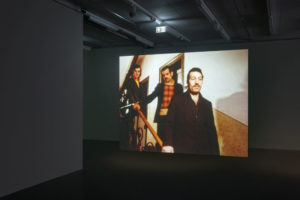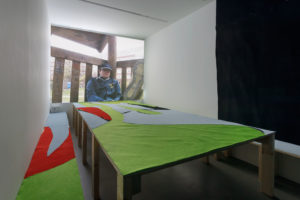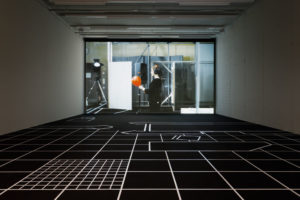Racism, social inequality, ethnic violence, politicization of history and censorship of minorities are crucial issues in the cultural and political discussion of our times. Globalization and violent conflicts in areas of recent economic and industrial development have encouraged massive migratory phenomena, to which the Old Continent finds itself intellectually and ideologically unprepared. The new wave of nationalist movements that has spread throughout Europe in recent years has exploited the recrudescence of an increasingly endemic economic crisis and the saturation of the capitalist system to channel social unease towards easy intolerance towards what is considered different, that becomes a scapegoat for the collapse of Western society.
The group show Because I live here currently ongoing at TOWER MMK, a collateral venue of the MUSEUM MMK FÜR MODERNE KUNST in Frankfurt, reflects on the difficulties of integration, institutional racism and stereotypes of national identity in Germany through video installations by 11 artists that aim to adopt the point of view of who is (or has been) a victim of violence or racial exclusion. The exhibition proposes a surgical path in the depths of recent national history and democratic failures to give voice to minorities often excluded from the media and government authorities’ debate. Attention to the truth of the facts and the awareness of entering an uncomfortable territory fraught with ideological pitfalls (including the mediocrity of a generic political correctness) induce the artists involved to adopt narrative techniques and languages based on the minimum intervention in which sometimes the concern not to give rise to misunderstandings and omissions ends up engulfing the specificities of artistic expression. The boundary between documentary and artist video is always very weak when the topics dealt disturb the conscience even without the need to formally elaborate the bare presentation. The work of the artists who manage to manipulate hot materials without betraying ethics and truth is therefore all the more courageous and authentic, if they don’t even hide behind the impermeable barrier of pure objectivity, offering genuinely participatory insights that are not afraid of sinking the knife in the criticality and complexity of the phenomena they analyze. And fortunately there are some in this exhibition.
The video by Želimir Žilnik, Inventory – Metzstrasse 11 (1975), shows for example the tenants of a popular apartment building in Munich who, descending a staircase, briefly present their personal stories. These are the so-called guest workers, immigrants from Italy, Spain, Greece, Turkey, Morocco, Portugal and Yugoslavia, who between 1955 and 1973 were encouraged to move to West Germany to strengthen its ties with trading partner countries. Their laconic stories highlight cultural uprooting and the need to move only to obtain acceptable working conditions, impossible in their native countries, without any real desire for integration. They talk about money and employment and the bureaucratic difficulties related to be immigrants, perceived by the German society as foreigners.
Erik van Lieshout in the video Rotterdam-Rostock (2006) tells in an amateur style his journey by bicycle from Rotterdam to Rostock, exploring with frankness and taste for the absurd the most needy areas he meets along his path. The artist interviews seniors, unemployed people, homeless neo-Nazis with an intimate and amused approach: the resulting social fresco brings out the neglect and ignorance of a variegated human panorama on the margins of society in which racial prejudices find an extremely fertile soil. Putting himself in the first place to gain the sincerity of the characters with whom he enters into a relationship, van Lieshout seems to live on his skin their discomfort, which mixes with his suffering for the recent end of a love story.
The elegant environmental installation by Henrike Naumann, 14 Words (2018) reproduces with spectral loyalty the interior of a former flower shop in Neugersdorf, Saxony. The work investigates the implicit symbolism of ideological extremisms, widespread as formal elements through analogical and digital communication or design. The title of the installation mentions a right numerical code born in the United States, but also familiar in Germany. The fourteen words to which the title allude “We must ensure the existence of our people and a future for white children”, meant that the number was used as a formula in various extremist right-wing contexts, including the manifesto known as NSU Bekenner -video. The cryptic transposition of the empty shop in the museum underlines the non-neutrality of the forms and recalls that all nine victims of the NSU attacks were immigrant entrepreneurs shot dead in their workplaces.
The video What would Nazis never do? (2017) by SPOTS. Audiovisual Micro-Interventions for Tribunal “Unraveling the NSU Complex” shows a survey carried out in the streets of Berlin in which an interviewer asks passers-by what means of transport the neo-Nazis use, strongly suggesting that they can travel by bicycle. The idea is considered absurd by all the respondents, although it is known that the NSU terrorists who robbed banks and blew up a bomb in front of the Yıldırım brothers’ hairdressing shop in Keupstraße fled by bike. With intelligent irony the work collides with the perception of media information and the stereotypes through which facts are evaluated by the general public, highlighting the flaws of communication and the groundlessness of certain instinctive references on which public opinion is based, undermining our safety preconceptions.
Minimal, lugubrious and desperately essential, the Normality 1 – X (1999–2001) project by Hito Steyerl shows a review of documentary images and footage of crime scenes to create a chronology of anti-Semitic and racist violence in Germany. From the repeated profanations of Jewish cemeteries and commemorative slabs to the victims of racial violence, whose progressive abandonment and degradation is mercilessly taken up by a fixed camera, a condition of disturbing normality emerges in which the perpetrators of vandalism and violence to people remain substantially unpunished with the connivance of political and judicial authorities.
Info:
Because I live here
Curator: Susanne Pfeffer with Anna Sailer
Artists: Harun Farocki, Azin Feizabadi, Forensic Architecture, Natasha A. Kelly, Erik van Lieshout, Henrike Naumann, Emeka Ogboh, spot_the_silence, SPOTS, Hito Steyerl, Želimir Žilnik
27 October 2018–18 August 2019
TOWER MMK
 Installation view TOWER MMK, Želimir Žilnik, Inventory – Metzstrasse 11, 1975, © Želimir Žilnik
Installation view TOWER MMK, Želimir Žilnik, Inventory – Metzstrasse 11, 1975, © Želimir Žilnik
 Erik van Lieshout, Rotterdam-Rostock, 2006, With the support of BerlinBiennale6 and the Mondriaan Fund, Courtesy the artist and Galerie Guido W. Baudach, Berlin
Erik van Lieshout, Rotterdam-Rostock, 2006, With the support of BerlinBiennale6 and the Mondriaan Fund, Courtesy the artist and Galerie Guido W. Baudach, Berlin
 Henrike Naumann, 14 Words, 2018, Courtesy Henrike Naumann and KOW Berlin, photo: Axel Schneider
Henrike Naumann, 14 Words, 2018, Courtesy Henrike Naumann and KOW Berlin, photo: Axel Schneider
 Installation view TOWER MMK, Forensic Architecture, 77sqm_9:26min, 2017, © Forensic Architecture, photo: Axel Schneider
Installation view TOWER MMK, Forensic Architecture, 77sqm_9:26min, 2017, © Forensic Architecture, photo: Axel Schneider
 Emeka Ogboh, Sufferhead Original (Frankfurt edition), 2018, Courtesy Emeka Ogboh
Emeka Ogboh, Sufferhead Original (Frankfurt edition), 2018, Courtesy Emeka Ogboh
 Installation view TOWER MMK, Azin Feizabadi, Cryptomnesia, 2014, © Azin Feizabadi, photo: Axel Schneider
Installation view TOWER MMK, Azin Feizabadi, Cryptomnesia, 2014, © Azin Feizabadi, photo: Axel Schneider
Graduated in art history at DAMS in Bologna, city where she continued to live and work, she specialized in Siena with Enrico Crispolti. Curious and attentive to the becoming of the contemporary, she believes in the power of art to make life more interesting and she loves to explore its latest trends through dialogue with artists, curators and gallery owners. She considers writing a form of reasoning and analysis that reconstructs the connection between the artist’s creative path and the surrounding context.






NO COMMENT